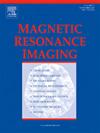Imaging of the renal allograft vasculature without gadolinium contrast: Intraindividual comparison between relaxation-enhanced angiography without contrast and triggering (REACT) and 4D contrast-enhanced MR-angiography
IF 2
4区 医学
Q2 RADIOLOGY, NUCLEAR MEDICINE & MEDICAL IMAGING
引用次数: 0
Abstract
Background
Complications after kidney transplantation include transplant renal artery stenosis (TRAS), which can be assessed using Doppler ultrasonography, computed tomography angiography, and magnetic resonance angiography (MRA). Contrast-enhanced MRA (CE-MRA) has limitations, including potential allergic reactions, limited use in kidney failure, and uncertain long-term effects of gadolinium retention.
Purpose
To evaluate Relaxation-Enhanced Angiography without Contrast and Triggering (REACT), a novel 3D isotropic flow-independent non-CE-MRA pulse sequence, for imaging of the renal allograft vasculature by performing an intraindividual comparison to 4D CE-MRA at 3Tesla.
Methods
Forty studies of 39 patients were included in this retrospective, single-centre study. Two board-certified radiologists independently evaluated MRA datasets for TRAS and rated their diagnostic confidence and the image quality of pelvic vessels using 5-point Likert scales (5 = excellent). Apparent signal- and contrast-to-noise ratios (aSNR/aCNR) were measured for arterial and venous graft vessels.
Results
REACT (median acquisition time 04:33 min [IQR 3:58–5:20 min]) showed 90.0 % sensitivity and 100.0 % specificity for TRAS in almost perfect agreement (r = 0.97) with 4D CE-MRA (03:41 min [3:38–4:46 min], p = 0.001) and similar diagnostic confidence (REACT: 4.0 [4.0–4.0] vs. 4D CE-MRA: 4.0 [3.0–4.0], p = 0.54). Arterial image quality was comparable (4.0 [3.7–4.4] vs. 4.0 [4.0–4.4], p = 0.49) whereas veins yielded higher scores in REACT (3.2 [3.0–3.5] vs. 2.4 [2.0–3.0], p < 0.001). Transplant renal artery (mean ± SD; 44.5 ± 18.2 vs. 45.9 ± 21.0, p = 0.71; 36.3 ± 15.0 vs. 41.0 ± 20.0, p = 0.16) and vein (37.1 ± 19.8 vs. 30.3 ± 15.2, p = 0.06; 29.4 ± 17.1 vs. 25.0 ± 14.7, p = 0.17) showed no difference in aSNR and aCNR.
Conclusion
REACT provides accurate detection of TRAS with image quality comparable to 4D CE-MRA, offering a risk-free alternative for imaging after renal transplantation.
不加钆造影剂的同种异体肾移植血管成像:不加造影触发的松弛增强血管造影(REACT)与4D增强磁共振血管造影的个体内比较。
背景:肾移植术后并发症包括移植肾动脉狭窄(TRAS),可通过多普勒超声、计算机断层血管造影和磁共振血管造影(MRA)进行评估。对比增强MRA (CE-MRA)有局限性,包括潜在的过敏反应,在肾衰竭中的有限应用,以及钆潴留的不确定长期影响。目的:通过与3Tesla的4D CE-MRA进行个体内比较,评估无对比触发松弛增强血管造影(REACT),这是一种新型的3D各向同性血流无关的非CE-MRA脉冲序列,用于异体肾移植血管成像。方法:本回顾性单中心研究纳入40项研究,39例患者。两名委员会认证的放射科医生独立评估TRAS的MRA数据集,并使用5点李克特量表(5 = 优秀)评定其诊断信心和骨盆血管的图像质量。测量动脉和静脉移植血管的表观信噪比(aSNR/aCNR)。结果:反应(平均收购时间04:33 min (IQR 3:58-5:20 min))显示90.0 %敏感性和100.0 % tra利用特异性的几乎完美的协议(0.97 r = )与4 d CE-MRA(03:41 min(3:38-4:46 min), p = 0.001)和类似的诊断信心(反应:4.0(4.0 - -4.0)与4 d CE-MRA: 4.0 (3.0 - -4.0), p = 0.54)。动脉图像质量相当(4.0 [3.7-4.4]vs. 4.0 [4.0-4.4], p = 0.49),而静脉在REACT中得分更高(3.2 [3.0-3.5]vs. 2.4 [2.0-3.0], p 结论:REACT提供了准确的TRAS检测,图像质量与4D CE-MRA相当,为肾移植后成像提供了无风险的替代方案。
本文章由计算机程序翻译,如有差异,请以英文原文为准。
求助全文
约1分钟内获得全文
求助全文
来源期刊

Magnetic resonance imaging
医学-核医学
CiteScore
4.70
自引率
4.00%
发文量
194
审稿时长
83 days
期刊介绍:
Magnetic Resonance Imaging (MRI) is the first international multidisciplinary journal encompassing physical, life, and clinical science investigations as they relate to the development and use of magnetic resonance imaging. MRI is dedicated to both basic research, technological innovation and applications, providing a single forum for communication among radiologists, physicists, chemists, biochemists, biologists, engineers, internists, pathologists, physiologists, computer scientists, and mathematicians.
 求助内容:
求助内容: 应助结果提醒方式:
应助结果提醒方式:


